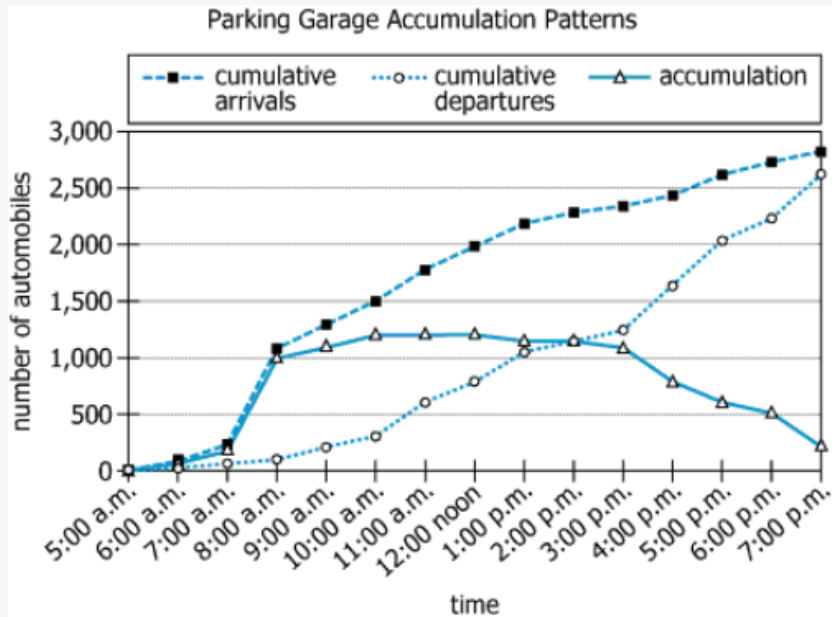KarishmaB wrote:
BottomJee wrote:
City X conducted a one-day study of accumulation patterns in a city-owned parking garage that contains a total of 1,200 parking spaces. The graph summarizes the cumulative arrivals (number of automobiles that had arrived at the garage), cumulative departures (number of automobiles that had departed the garage), and accumulation (number of automobiles occupying the garage) at one-hour intervals from 5:00 a.m. to 7:00 p.m. on the day of the study.

Each of the following options describes a condition that occurred at least once between 5:00 a.m. and 7:00 p.m. on the day of the parking study.
For each option, select Before 1:00 p.m. if the first such occurrence was before 1:00 p.m. Otherwise, select 1:00 p.m. or later.
At every hour, accumulation would be "cumulative arrivals till that hour - cumulative departures till that time."
For example, At 10:00 AM cumulative arrivals are 1500 and cumulative departures are 300. Note that accumulation is 1200 at that time.
Makes sense, right?
If someone tells you at 10:00 AM - till morning, 1500 cars have come in total and 300 cars have left. Can you say that 1200 cars are still inside the parking space? Sure. the good thing here is that they have already given you the amount of accumulation every hour so you don't need to calculate it.
Cumulative arrivals were greater than accumulation.Cumulative arrivals will always be either greater than or equal to accumulation (if no one leaves). By 6:00 AM, departures may be 0 so arrivals may be equal to accumulation but by 7:00 AM there were some departures too and arrivals became greater than accumulation.
Hence select "
Before 1:00 PM"
@Engineer1 - The graph indicates when the departures started.
Cumulative arrivals were greater than 2 times cumulative departures.Look at 8:00 AM. Cumulative arrivals were many times greater than cumulative departures.
Hence select "
Before 1:00 PM"
Cumulative departures were greater than accumulation.Cumulative departures line is above the accumulation line for the first time at 3:00 PM. Hence Cumulative departures were greater than accumulation for the first time at 3:00 PM.
Hence select "
After 1:00 PM"
Thank you,
KarishmaB. Yes, I see that the cumulative arrival will always be greater than accumulation. Even the graph indicates that before or after 1:00 PM. Why is the answer only before 1PM? Arrival is always > accumulation, unless the data shows Departure has exceeded Arrival at some point. My reasoning is below.
I took the following data points and in every case it is A > AC.
At 7 AM, Arrival (A) = 250; Departure (D) ~ 50, thus, Accumulation (AC) = ~200
At 11 AM, A = ~1800, D = ~600, this, AC = ~1200
At 1 PM, A = ~2200, D = ~1100, this, AC = ~1100
At 4PM, A =~2450, D = 1600, thus AC = ~750
At 7PM, A =~2800, D = 2600, thus AC = ~200
So far I gathered that many of these DI questions are "intuitive" rather than involving complex calculations and data analysis. I am missing that intuition part. Any suggestion? Thanks.




 65%
(hard)
65%
(hard)
 40%
(02:38)
wrong
40%
(02:38)
wrong  based on 314
sessions
based on 314
sessions
